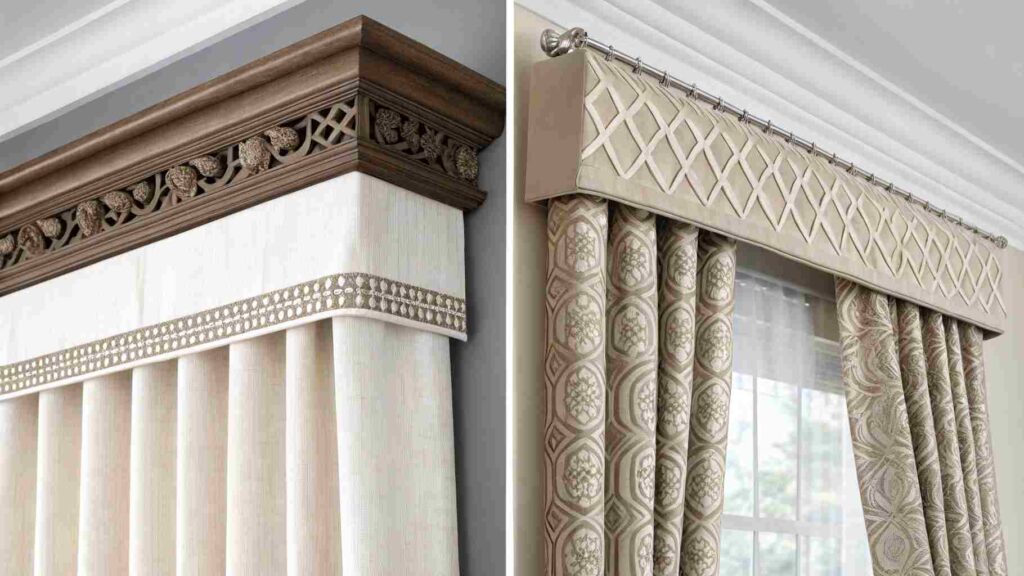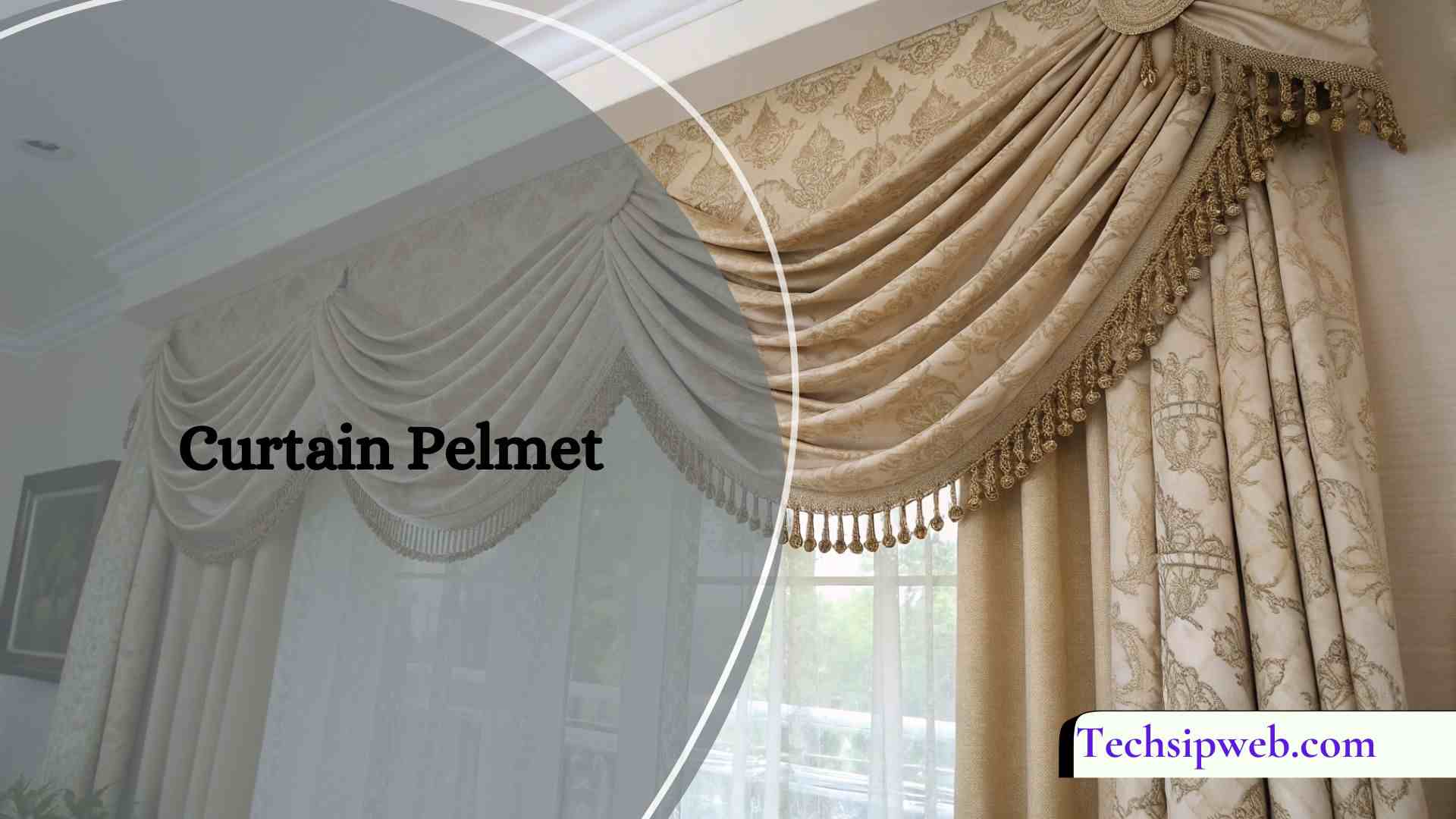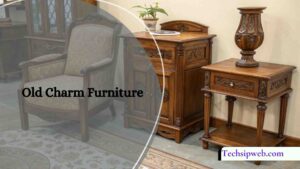A curtain pelmet is a decorative framework placed above windows to hide curtain rods and improve insulation. It adds a clean, elegant look while helping block light and reduce energy loss.
Stay tuned with us! We’ll be sharing more simple and helpful ideas about curtain pelmets—how to use them, style them, and make your windows look great.
What is a Curtain Pelmet?
A curtain pelmet is a framework that sits above your window to cover curtain fittings, tracks, or rods. While primarily decorative, it also serves to:
- Improve thermal insulation
- Enhance room aesthetics
- Block out external light
- Create a cleaner, more structured appearance
Pelmets are commonly constructed from wood, MDF, or foam-core board and may be painted, upholstered, or even carved for added detail.
A Brief History of Curtain Pelmets:
Curtain pelmets trace their origins back to 17th-century Europe, particularly in France and England, where elaborate window dressings signified wealth and social status. Aristocrats used richly carved wooden pelmets, often gilded or painted to match interior molding.
Over time, pelmets evolved into simpler forms, making their way into Victorian homes and eventually mid-century and contemporary architecture. Today, the pelmet has made a strong comeback as both a classic design element and a modern insulation hack.
Functional Advantages of Curtain Pelmets:
Let’s dive deeper into the functionality of pelmets beyond aesthetics:
Thermal Regulation:
By preventing warm or cool air from escaping between the curtain and ceiling, pelmets improve a room’s thermal efficiency. Studies show that homes with pelmet-enhanced curtains can experience up to a 20% improvement in insulation during extreme weather months.
Energy Savings:
Incorporating pelmets as part of your window treatment can help reduce HVAC costs. With rising energy bills across the U.S., this small addition can contribute to long-term savings.
Concealment:
Pelmets hide unsightly curtain rods, hooks, or motorized tracks. They also tidy up window finishes where drywall, trim, or cornices meet.
Light Blocking:
When paired with blackout curtains, pelmets prevent light from leaking in at the top, perfect for shift workers, nurseries, or media rooms.
Design Styles and Types of Curtain Pelmets:

Curtain pelmets are incredibly versatile and can be customized to suit various design aesthetics.
Box Pelmet:
- Structure: Straight lines, clean edges
- Ideal For: Minimalist or modern interiors
- Materials: MDF or timber, often painted or upholstered
Fabric-Covered Pelmet:
- Structure: Soft surface, padded look
- Ideal For: Bedrooms, traditional or romantic themes
- Pro Tip: Use contrasting fabric for a statement piece
Wooden or Carved Pelmet:
- Structure: Solid wood, sometimes intricately carved
- Ideal For: Heritage homes, classical interiors
- Finish: Can be stained, painted, or gilded
Shaped Pelmet:
- Structure: Curves, waves, or custom cut-outs
- Ideal For: Boho, artistic, or eclectic spaces
- Unique Factor: Offers a playful or creative flair
Cost of Curtain Pelmets: What to Expect:
DIY Pelmet:
- Material Cost: $20–$80
- Time Investment: 3–6 hours
- Tools Needed: Saw, drill, staple gun, fabric, foam
Custom-Built Pelmet:
- Cost Range: $200–$600 per window
- Variables: Size, materials, upholstery, professional fees
Ready-Made Pelmets:
- Retail Price: $50–$250
- Available At: Wayfair, IKEA, Amazon, Pottery Barn, Home Depot
Pelmet vs. Valance: What’s the Difference?
While often used interchangeably, pelmets and valances serve different design purposes:
| Feature | Pelmet | Valance |
| Structure | Rigid frame | Soft, flowing fabric |
| Material | Wood, MDF, upholstered board | Fabric only |
| Functionality | Better insulation, light block | Mostly decorative |
| Style Suitability | Modern, formal | Casual, traditional |
For a more tailored and polished look, pelmets are generally the preferred option—especially in upscale, contemporary, or transitional interiors.
Styling Curtain Pelmets by Architectural Theme:
Farmhouse:
Use reclaimed wood for a rustic, charming pelmet. Pair it with neutral linen curtains.
Urban Loft:
Try a matte black or metal-effect pelmet for an industrial edge.
Classic Colonial:
Opt for carved wooden pelmets in rich mahogany or cherry wood.
Zen Minimalist:
Choose a seamless pelmet that blends into the wall color—less is more.
DIY Curtain Pelmet Tutorial (Step-by-Step):
What You’ll Need:
- MDF board (cut to width of window)
- Foam padding
- Fabric (matching or contrast)
- Staple gun
- Brackets and screws
Instructions:
- Cut the board to size and wrap with foam padding.
- Stretch fabric over the foam and staple at the back.
- Attach side returns if desired for a 3D box shape.
- Mount brackets to the wall and secure the pelmet.
Pro Tip: Add piping trim or nailhead studs for a designer finish.
Eco-Friendly Curtain Pelmet Options:
Sustainability is no longer optional—it’s essential. Here are some eco-conscious materials:
- Bamboo or reclaimed wood for hard pelmets
- Recycled foam and organic cotton for upholstered versions
- Low-VOC adhesives and finishes to reduce toxic emissions
Look for brands that offer LEED-certified materials or support sustainable forestry.
Smart Home Integration: Pelmets with Motorized Curtains:
In 2025, smart homes are becoming the norm, and curtain pelmets are catching up:
- Motorized tracks can be concealed within pelmets
- Alexa or Google Assistant integration for voice control
- Programmable schedules to open/close curtains for light optimization
- Add LED lighting strips under pelmets for ambiance and visibility
This makes pelmets not just aesthetic, but part of your home’s automation ecosystem.
Where to Shop for Curtain Pelmets in the U.S:
| Store | Type | Specialty |
| Wayfair | Online Retail | Customizable styles, wide range |
| Home Depot | In-store & Online | DIY supplies, pre-made pelmets |
| Pottery Barn | Retail/Designer Pieces | Upscale, upholstered pelmets |
| Etsy | Handmade/Custom | Unique and artisan-crafted pelmets |
| Local Drapery Shops | Custom/Professional | Tailor-made to fit window perfectly |
FAQ’s
1. Can curtain pelmets be used with blinds instead of curtains?
Yes! Curtain pelmets can be installed above roller blinds, Roman shades, or Venetian blinds to hide hardware and enhance insulation. This combination gives a sleek, modern look while improving energy efficiency and blocking light leaks.
2. Are curtain pelmets suitable for rental homes or apartments?
Yes, but consider removable or tension-mounted options. Lightweight pelmets made from foam or fabric can be attached with Velcro or command strips, allowing renters to enhance their window design without damaging walls.
3. How do I clean or maintain a fabric-covered pelmet?
Use a handheld vacuum with a soft brush attachment for regular dusting. For deeper cleaning, spot-clean with a fabric-safe solution or consult a professional cleaner, especially for upholstered or decorative fabrics.
4. Can pelmets reduce outside noise?
While not a primary solution for soundproofing, pelmets combined with heavy curtains can slightly reduce outside noise by sealing gaps at the top of windows, contributing to a quieter environment.
5. How do I choose the right height and depth for a pelmet?
A general rule: make the pelmet 10–20% of the total curtain length in height. The depth should be enough to cover the curtain rod or track—typically around 4 to 6 inches, but deeper for motorized systems. Custom sizing ensures both function and proportionate design.
Conclusion:
Curtain pelmets are a smart and stylish way to upgrade any room. They hide curtain hardware, save energy, block light, and add a clean, finished look. With so many styles and materials to choose from, pelmets can match any décor and make your windows look truly complete.






